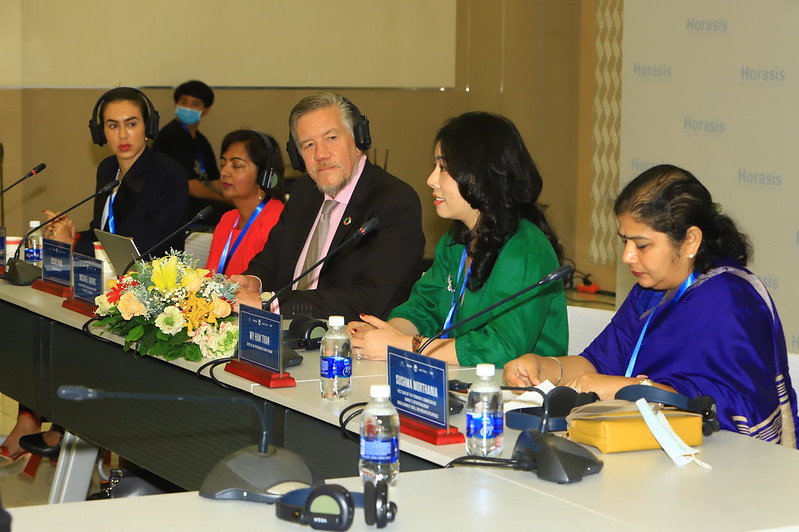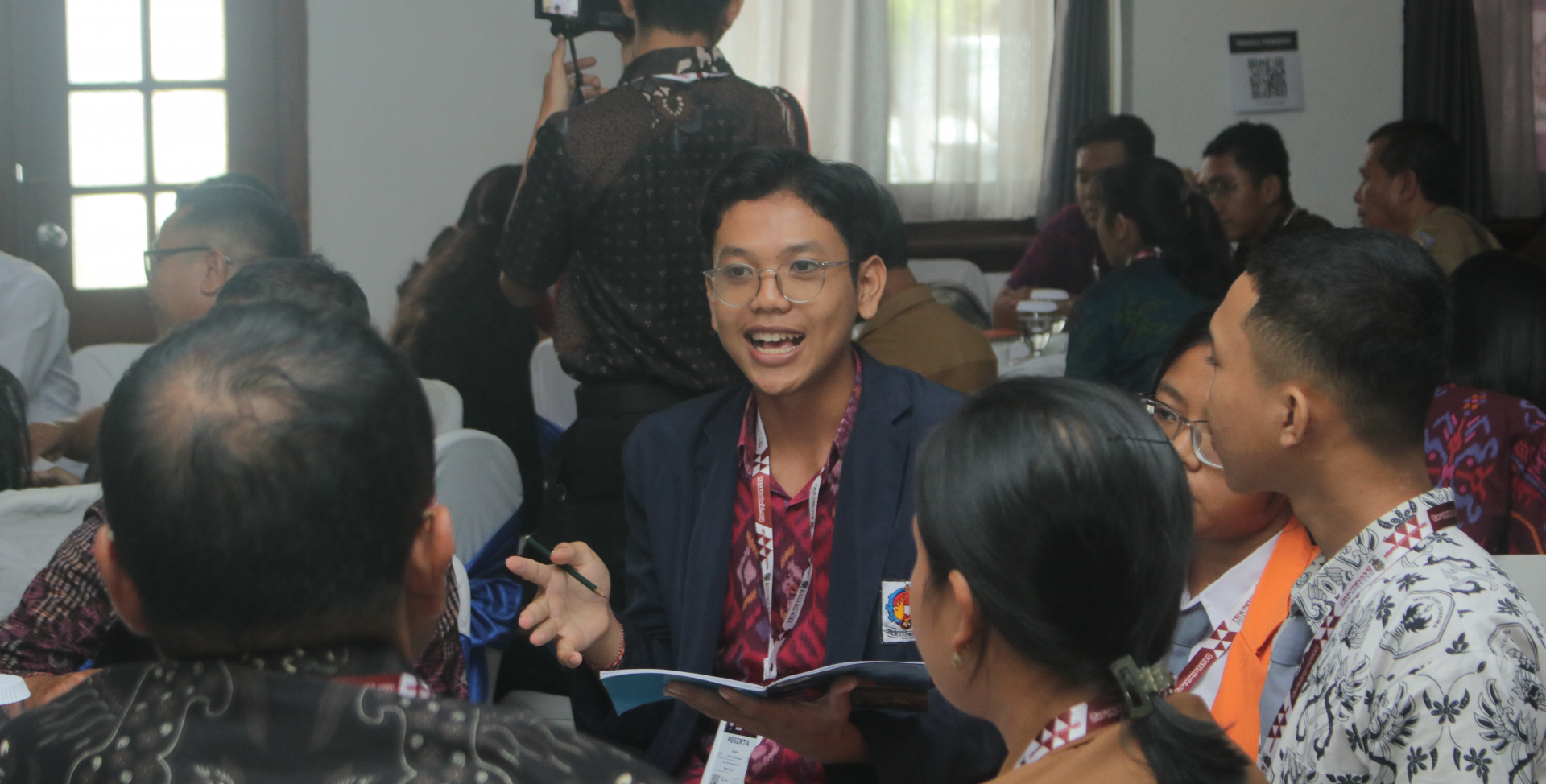Female leadership – We need it more than ever
Multiple studies indicate that female leaders outperform their male counterparts in globally critical areas like handling the COVID-19 crisis or environmental and social governance (ESG) – including measures to counter climate change. So why do women remain vastly underrepresented in leadership positions? What needs to happen to achieve parity? A panel discussion on female leadership, which I chaired at the recent Horasis India Meeting in Vietnam, looked for answers.
In a packed conference room, panelists and a mixed audience shared thoughts, views and experiences that reflected the interest and controversy surrounding gender politics. Although a 1-hour forum can only scratch the surface, a number of key insights emerged.
Gender and leadership
Any discussion of gender disparity in public- and private-sector leadership positions must begin with a look at what gender is in the first place. Needless to say, large numbers of people define their genders beyond the binary male-female divide. But for the moment, let’s focus on the biological characteristics that separate men from women. Men are, on average, somewhat bigger, physically stronger and faster than women. They are also – on average – more aggressive. I cannot emphasize enough that these are statistical averages only. A single differentiator that can be defined as absolute is that females have the physical capacity to bear children and produce breastmilk.
There is a massive body of research pointing to psychological differences between genders, yet there is scarce sound evidence as to which and to what extent such traits are the result of biological makeup or conditioning (nature vs. nurture). In any case, they are extremely subtle compared to those of other species. Consider, for example, the multitude of bird and fish species in which males and females have completely different coloring, behavior and body size. Or mammals such as lions or elephants, whose physiognomy and role within their respective communities are widely divergent.
This is by no means to say that no differences whatsoever exist between human males and females. It’s simply that these variances in traits, such as they are, are (1) minor and (2) have absolutely no bearing on an individual’s aptitude for leadership.
Which brings us to the topic of leadership. For eons, rulers came by their positions of power and authority almost exclusively by birthright. Leaders begat leaders. Not until the industrial revolution, which empowered non-aristocrats to achieve wealth and power through hard work, ingenuity and the ability to lead large numbers of workers, did literature emerge exploring leadership as a talent that was not necessarily hereditary. Not surprisingly, the body of work on the topic that took shape in the 19th century is referred to as “great man theory.” Much of it is linked to the work of the historian Thomas Carlyle, who stated that “the history of the world is but the biography of great men.” A leader was defined as a man gifted with unique qualities that inspire and motivate the masses.
Fast-forward to the post-World War II era and we see the first discussions of leadership as a learnable skillset. Today we’re inundated with theories, how-to literature, seminars, training programs and one-on-one coaching offers on the topic. Like any other skillset, people start out with varying degrees of talent and motivation to develop, but there can no longer be any doubt that leadership is learnable.
So where does this take us?
If we agree that women and men are equally capable of leadership and that leadership is learnable, we must ask why women remain underrepresented in executive positions, and how to achieve parity. To place the situation in perspective, the proportion of women in senior management is growing globally, rising from 25% in 2017 to 31% in 2021. Considering that women constitute half the world population, this progress is modest at best. The panel discussion at the recent Horasis India Meeting, a gathering of international public- and private-sector leaders focused on economic growth and cooperation across South and Southeast Asia, cast some light on the subject. The panelists were extraordinarily well qualified to speak on the subject: Francesca Gatti, Program Manager, Princess Diya Kumari Foundation, India; Sushma Morthania, Director General at India SME Forum; Jessie Paul, Founder, Paul Writer, India; My Han Tran, Director, My Han Manufacturing and Trading, Vietnam.
The time is ripe to cast a spotlight on South and Southeast Asia: with China focusing its economic policy increasingly inward and slowing its Belt and Road initiative, new growth and development opportunities are opening up. As the world emerges from the pandemic and its economic fallout, the dynamically growing economies of these regions, which have proven their capacity for embracing new tech, “leapfrogging” legacy systems and technologies that exist in the Global North, are particularly well positioned to build back better. And there is a strong case for improving gender parity as part of the process: it has been empirically shown to benefit a nation’s innovative strength, entrepreneurship and overall quality of life, while gender disparity has real and measurable human and economic costs.
A 3-D approach to gender parity
Addressing gender disparity in general and underrepresentation of women in leadership specifically must take place in three distinct, but interacting, dimensions: education, organizational change, governmental policymaking. Within the educational and training dimension, there is a clear need for measures to foster mindset shifts across genders. “It’s not always in our power to overcome or change the barriers women face in their career paths,” says clinical psychologist and mindfulness trainer Kerri Cummings, who gives seminars for female high potentials at major corporations through her company Mindbar. “But on an individual level, women can work on their own limiting beliefs, learn how to play the game so you can stay in it and thrive. And, we can support other women, resisting the natural tendency to see one another as competition and making it a conscious goal to be allies.” Seminars and mentorship programs to cultivate mutual supportiveness and empowerment among women is an important component, but change also needs to include all genders.
Paradoxically, many corporations have made top-level policy decisions to promote more women, yet have not seen the expected numbers of candidates step up. “Underrepresentation of women in leadership is a male problem, not a female one,” says Navroop Sahdev, Founder and CEO of the global impact organization The Digital Economist and MIT Connection Science Fellow. “We can talk about female empowerment until we’re blue in the face, but until men adopt a new understanding of gender roles, we’re not going to see change.”
One of the recommendations that emerged during the Horasis panel discussion on female leadership was that organizations need to introduce programs that pair male executives with female mentees. As panelist Francesca Gatti points out, “effective leaders are aspirational and inspirational, and characteristics pertinent to leadership are not gender-specific. Social stereotypes presenting male leaders as more salient than female leaders are misleading, since both men and women show effective leadership traits when provided with appropriate infrastructure and resources.” Measures that systematically bring all genders together and require the traditional male executive class to treat all as equals are a further part of the solution. “Fundamental is the incorporation of men in the entire process,” Gatti adds. Such measures embody both education and organizational change, implemented on a voluntary basis. As important as they are, such measures are clearly not enough.
Who’s afraid of the big bad quota?
As panelist Jessie Paul writes in an insightful blog post titled Women as Leaders are the same as men. Almost., “we need to use affirmative action to balance things out. In the long run it will be of huge benefit in tapping into a more diverse pool of talent and boosting the economic growth.” One example brought up in the panel discussion is that in India, every executive board is required to include at least one female director. This simple piece of legislation has made female presence in the country’s C-suites the norm, even if it’s not enough to achieve true parity in and of itself. Above all, it represents a step toward resolving the chicken-and-egg conundrum: as past experience is a key criterion in the selection of candidates for executive positions, scarcity of women with leadership experience results – in turn – in fewer female leaders. A government-mandated quota not only increases the pool of female staff with leadership experience, but also incentivizes organizations to groom women for such positions and promote first-timers.
This take on state intervention was backed by panelist Sushma Morthania, who pointed out in a recent op-ed that government initiatives such as loan schemes and public procurement requirements in India have supported a surge in female entrepreneurship. One particularly relevant example is a program to support self-help groups of women entrepreneurs with micro-loans, while helping them develop their decision-making skills. This is enabling communities to overcome regional imbalances as well as information asymmetries. The proportion of women among the country’s entrepreneurs has grown from 14% to 20% over the past five years, employing more than 13 million people and contributing 17% to India’s GDP.
Still, any top-down government requirement will always be a blunt instrument. Without education and organizational change, such measures can fuel divisiveness and resentment. Aside from which, no woman wants to see herself – nor be seen by others – as the “token” female leader, hired because of a quota. We all have a right to be recognized for our merits, not our gender.
A 2013 paper titled How Costly is Diversity? Affirmative Action in Light of Gender Differences in Competitiveness presents a study examining whether high-performing women can be encouraged to enter into competitions. The authors challenge the frequently voiced objection that affirmative action “results in reverse discrimination and lowers the qualifications of selectees.” They assert that prior research shows that well qualified women are less likely than their male counterparts to enter into a competitive environment alongside men.
In their study, involving payment for completing mathematical tasks, men and women were given a choice between a competitive scheme and a non-competitive piece-rate model. Only 31% of women chose the competitive option, as opposed 74% of men. Given the same choice, but with the guarantee that one of the two winner positions would go to the top-performing female participant, women’s willingness to compete increased by 25 percentage points while men’s willingness to compete decreased by 9 percentage points. This meant that 56% of women chose to compete alongside 61% of men, nearly closing the gender gap.
The path to future parity
Public- and private-sector organizations need good leadership, especially in these fast-changing and challenging times, marked by geopolitical uncertainty and urgency to address catastrophic climate change. Yet the pool of high-potentials willing to take on the hard work and responsibility involved in leadership is and will remain limited. Empowering, encouraging and enabling women to join that cohort will not only increase overall available talent, but also – by sheer numbers – raise the bar in terms of leadership quality. While quotas and other government-mandated measures may be imperfect, results in India and elsewhere show that they work. A stronger female presence in the upper echelons of political and business leadership will not only establish a new paradigm of gender neutrality, but also send an important signal to young women that such a career trajectory is open to them should they choose it.
One day, we will look back on all-male boards of directors and the controversy surrounding affirmative action as an absurd anachronism – like the debate over whether cars should be fitted with catalytic converters or whether ice hockey players should be required to wear helmets. But for now, the world needs government mandates. Supported by education and organizational change, affirmative action can foster the sea change needed to make gender parity the norm in the world’s C-suites – to the benefit of economies, the environment and society as a whole.




